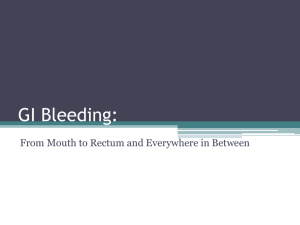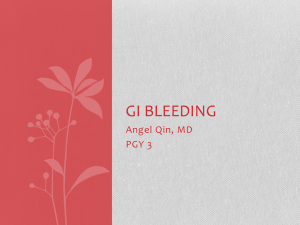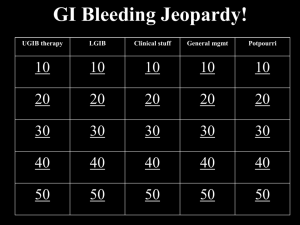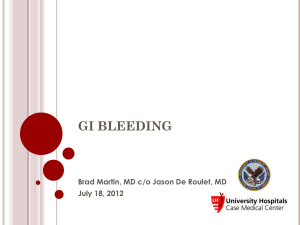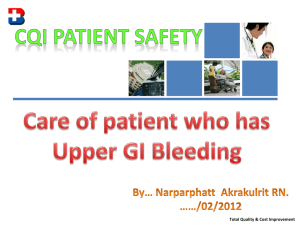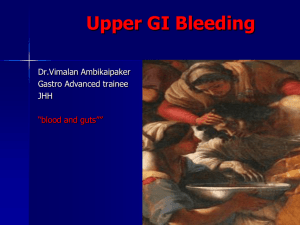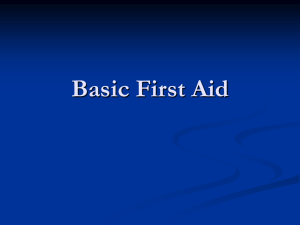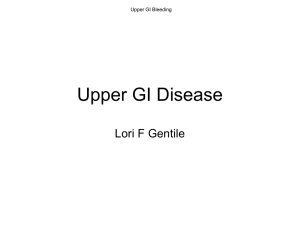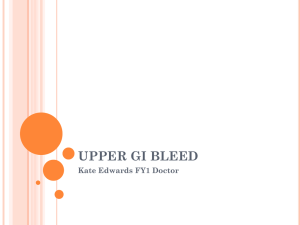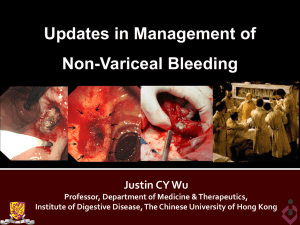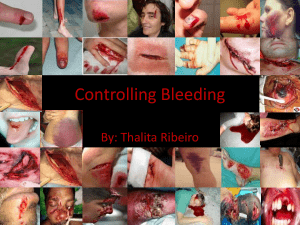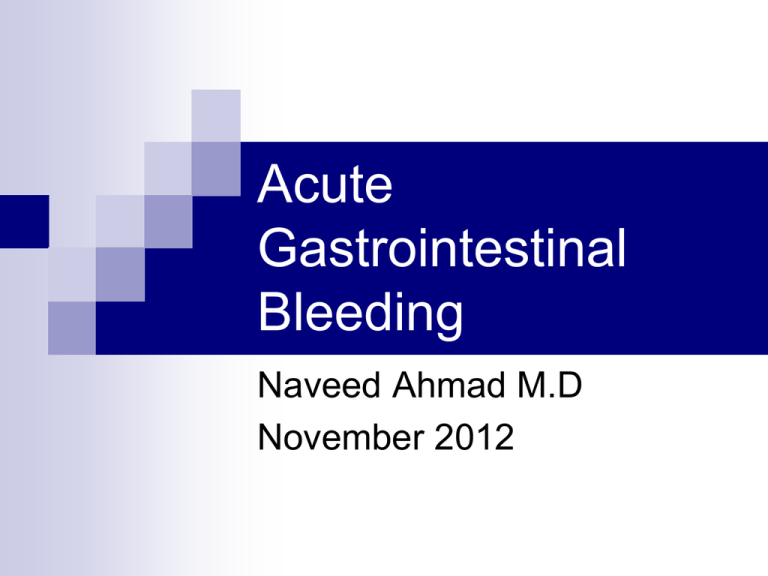
Acute
Gastrointestinal
Bleeding
Naveed Ahmad M.D
November 2012
QUESTION 1
Endotracheal intubation for airway protection in the
management of acute Upper GI bleeding should be
considered:
A. in all cirrhotic patients
B. in all patients with UGI bleeding
C. in patients with altered mental status and ongoing
hematemesis
D. in patients with stable COPD
E. in all patients unless it delays urgent endoscopy
QUESTION 2
A 73 year old man presents with several episodes of
hematemesis. Examination shows signs of orthostatic
hypotension and melena. What is the first priority in
caring for this patient?
A. Nasogastric tube placement and gastric lavage.
B. Resuscitation with adequate IV access and
appropriate fluid and blood product infusion.
C. Intravenous infusion of H2-receptor antagonists to
stop the bleeding.
D. Urgent upper endoscopy.
E. Urgent surgical consultation.
QUESTION 3.
A 58 year old female patient presents to the ED with a 24-hour
history of several bloody bowel movements. She denies any
abdominal pain but complains of light headedness. She is found to
be hypotensive with systolic blood pressure of 90mmHg supine. Hb
7gm/dl. Resuscitative measures are instituted. What is the most
appropriate next step?
A. Nasogastric tube placement
B. Flexible sigmoidoscopy
C. Colonoscopic examination
D. Tagged RBC scan
E. Angiography
Intraluminal blood loss
anywhere from
oropharynx to anus
Upper : above ligament of
Treitz
Lower Below the ligament
of Treitz
Incidence
Annual rate of hospitalization for any type of GIB in US
350/100,000
Annually, approximately 100,000 patients are admitted to
US hospitals
UGIB 50%, Lower GIB 40%, 10% obscure bleeding.
Mortality rates from UGIB are 6-10% overall
The incidence of UGIB is 2-fold greater in males than in
females, in all age groups; however, the death rate is
similar in both sexes
Signs
Hematemesis : blood in vomitus (UGIB)
Hematochezia : bloody stools (LGIB or rapid UGIB)
Melena : Black Tarry stools from digested blood (Usually
UGIB but can be anywhere including right colon)
Etiologies (UGIB)
Source
Duodenal Ulcer
Gastric Erosions
Gastric Ulcer
Esophagogastric Varices
Mallory-Weiss tear
Esophagitis
Erosive Duodenitis
Prevalence (%)
24.3
23.4
21.3
10.3
7.2
6.3
5.8
Etiologies (UGIB)
Oropharyngeal bleeding and epistaxis
Immunocompetent host : GERD/Barrett’s/XRT
Immunocompromised host : CMV,HSV, Candida
Vascular Malformations (5%)
Dieulafoy’s
Lesion (superficial ectatic artery in cardia > sudden massive UGIB)
AVMs (isolated or with Osler-Weber-Rendu
syndrome)
Aorto-enteric fistula (AAA or aortic graft erodes into
3rd portion of duodenum;presents with herald bleed)
Vasculitis
Neoplastic disease (esophageal or gastric)
Etiologies (LGIB)
Source
Diverticulosis
Colonic Angiodysplasia
Ischemic Colitis
Malignancy
Hemorrhoids/Anorectal
Postpolypectomy
Unknown
Prevalence (%)
17 – 44
2 – 30
9 – 21
4 – 14
4 – 11
6
8 - 12
Clinical Manifestations
UGIB>LGIB: Nausea, vomiting, hematemesis, coffee
ground emesis, epigastric pain, vasovagal reaction,
syncope, melena
LGIB>UGIB: Diarrhea, tenesmus,BRBPR or maroon
stools
Work Up
History : Acute or chronic GIB, number of episodes, most
recent episode, hematemesis, vomiting prior to
hematemesis, melena, hematochezia, abdominal pain,
use of NSAIDs, anti coagulants, alcohol abuse, cirrhosis,
prior GI or aortic surgery
Physical Exam
Tachycardia at 10% volume loss
Orthostatic hypotension at 20% loss
Shock at 30% volume loss
Pallor, talengectesia (ETOH,cirrhosis, OWR Synd)
Chronic liver disease: jaundice,spider angiomata,
gynecomastia, testicular atrophy, palmer erythema,
caput medusae
Localized abdominal tenderness or peritoneal signs,
masses, signs of prior surgery
Rectal Exam: appearance of stools, hemorrhoids, anal
fissure
Lab Studies
Hct: maybe normal before equiliberation which may take
24 hours, decreased 2-3%-> loss of 500cc blood.
Platelet count, PT,PTT BUN/Cr (ratio>36 in UGIB due to
GI resorption of blood and prerenal azotemia)
LFTs
NG tube: Useful for localization (presence of non-boody
bile in lavage excludes active bleeding proximal to
ligament of Treitz), can also clear GI contents prior to
EGD and detect continued bleeding
Glasgow-Blatchford Score
Admission risk marker Score component value
Blood Urea
≥6·5 <8·0
2
≥8·0 <10·0
3
≥10·0 <25·0
4
≥25
6
Haemoglobin (g/L) for men
≥12.0 <13.0
1
≥10.0 <12.0
3
<10.0
6
Haemoglobin (g/L) for women
≥10.0 <12.0
1
<10.0
6
Systolic blood pressure (mm Hg)
100–109
1
90–99
2
<90
3
Other markers
Pulse ≥100 (per min)
1
Presentation with melaena 1
Presentation with syncope 2
Hepatic disease
2
Cardiac failure
2
scores of 6 or more were associated with a greater than 50% risk of
needing an intervention
Rockall Score
A score less than 3 carries good prognosis but total score more than 8 carries high
risk of mortality
Diagnostic Studies
UGIB EGD (potentially therapeutic)
LGIB
(r/o UGIB)
Stable. Spontaneously stops- colonoscopy diagnostic in 70%
cases also potentially therapeutic
Stable, ongoing bleeding- colonoscopy or Bleeding scan (Tc
tagged RBC/albumin) detects rates >0.1 ml/min, localization
difficult
Unstable, arteriography bleeding rates >0.5ml/min, potentially
therapeutic
Ex Lap
RBC scan
Angiogram
Treatment
IV access with 2 large bore (18 gauge or larger) IV lines
Vol resuscitiation (saline, Ringer’s)
Transfusion therapy
Correct Coagulopathies
NG/Prokinetics
Airway management
Consult GI and Surgery service as needed
Peptic Ulcer Disease
Pharmacologic therapy
High Dose PPI therapy (Pantoprazole 80 mg IV bolus
followed by 8gm/hr infusion)
Endoscopic therapy (Injection, Thermal, Laser)
Arteriography with embolization
Surgery if endoscopic and pharmacologic therapy fails
Varices
Pharmacologic
50 microgram IVB 50microgram/hr
infusion (84% success; Lancet 1993)
Non Selective Beta Blocker therapy (once stable)
Octreotide
Non Pharmacologic
EVL
has replaced sclerotherapy (>90% success)
Balloon Temponade (Sengstaken-Blakemore)
TIPS if Endoscopy fails
Mallory-Weiss Tear
Usually
stops spontaneously, endoscopic
therapy if active
Esophagitis/Gastritis
PPI,
H2- Antagonists
Diverticular Disease
Usually stops spontaneoulsy
Endoscopic therapy
Arterial vasopressin or embolization
Surgery
Angiodysplasia
Endoscopic therapy
Arterial vasopressin
Surgery
Hormonal therapy
Risks of Rebleeding without
Endoscopic Intervention
90
80
70
60
50
40
30
20
10
0
Active
bleeding
NBVV
Clot
Pigmented Clean base
spot
Summary
Acute GI bleeding remains a important cause for
morbidity, hospital admissions and mortality
Early and prompt resuscitation is the key to management
Diagnostic and therapeutic modalities are ever improving
Thank you
QUESTION 1
Endotracheal intubation for airway protection in the
management of acute Upper GI bleeding should be
considered:
A. in all cirrhotic patients
B. in all patients with UGI bleeding
C. in patients with altered mental status and ongoing
hematemesis
D. in patients with stable COPD
E. in all patients unless it delays urgent endoscopy
QUESTION 2
A 73 year old man presents with several episodes of
hematemesis. Examination shows signs of orthostatic
hypotension and melena. What is the first priority in
caring for this patient?
A. Nasogastric tube placement and gastric lavage.
B. Resuscitation with adequate IV access and
appropriate fluid and blood product infusion.
C. Intravenous infusion of H2-receptor antagonists to
stop the bleeding.
D. Urgent upper endoscopy.
E. Urgent surgical consultation.
QUESTION 3.
A fifty-eight year old female patient presents to the emergency
department with a 24-hour history of several bloody bowel
movements. She denies any abdominal pain but complains of light
headedness. She is found to be hypotensive with systolic blood
pressure of 90mmHg supine. Hb 7gm/dl. Resuscitative measures
are instituted. What is the most appropriate next step?
A. Nasogastric tube placement
B. Flexible sigmoidoscopy
C. Colonoscopic examination
D. Tagged RBC scan
E. Angiography

